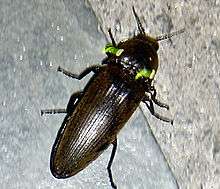Pyrophorus noctilucus
| Pyrophorus noctilucus | |
|---|---|
 | |
| Jamaican click beetle Pyrophorus noctilucus | |
| | |
| Pyrophorus noctilucus from Argentina. Mounted specimen | |
| Scientific classification | |
| Kingdom: | Animalia |
| Phylum: | Arthropoda |
| Class: | Insecta |
| Order: | Coleoptera |
| Family: | Elateridae |
| Subfamily: | Agrypninae |
| Genus: | Pyrophorus |
| Species: | P. noctilucus |
| Binomial name | |
| Pyrophorus noctilucus (Linnaeus, 1758) | |
| Synonyms | |
| |
Pyrophorus noctilucus, common name Headlight Elater, is a species of click beetle (family Elateridae).
Description
Pyrophorus noctilucus can reach a length of 20–40 millimetres (0.79–1.57 in). The basic coloration is dark brown. The antennae are serrate. The pronotum shows a long backward-pointing tooth.
These beetles are bioluminescent by means of two luminescent light organs at the posterior corners of the prothorax, and a broad area on the underside of the first abdominal segment. Their bioluminescence is similar to that of another group of beetles, the fireflies, although click beetles do not flash, but remain constantly glowing (though they can control the intensity; for example, they become brighter when touched by a potential predator). Also the larvae and the pupae have light organs and the eggs are luminous too.
Adults feed on pollen, fermenting fruit and sometimes small insects, while the larvae live in the soil and feed on various plant materials and invertebrates, as well on the larvae of other beetles.
Distribution
This species can be found in Saint Vincent & the Grenadines, Argentina, Cayman Islands, Mexico, Panama, Colombia, Venezuela, Trinidad and Tobago, Guyana, Suriname, Brazil, Ecuador, Peru, Bolivia, Texas, South Florida, Hawaii , Cuba , Puerto Rico and Dominican Republic.